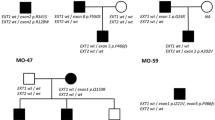Abstract
Hereditary multiple exostoses (EXT; MIM 133700) is an autosomal dominant bone disorder. It is genetically heterogeneous with at least three chromosomal loci: EXT1 on 8q24.1, EXT2 on 11p11, and EXT3 on 19p. EXT1 and EXT2, the two genes responsible for EXT1 and EXT2, respectively, have been cloned. Recently, three other members of the EXT gene family, named the EXT-like genes (EXTL: EXTL1, EXTL2, and EXTL3), have been isolated. EXT1, EXT2, and the three EXTLs are homologous with one another. We have identified the intron-exon boundaries of EXTL1 and EXTL3 and analyzed EXT1, EXT2, EXTL1, and EXTL3, in 36 Chinese families with EXT, to identify underlying disease-related mutations in the Chinese population. Of the 36 families, five and 12 family groups have mutations in EXT1 and EXT2, respectively. No disease-related mutation has been found in either EXTL1 or EXTL2, although one polymorphism has been detected in EXTL1. Of the 15 different mutations (three families share a common mutation in EXT2), 12 are novel. Most of the mutations are either frameshift or nonsense mutations (12/15). These mutations lead directly or indirectly to premature stop codons, and the mutations generate truncated proteins. This finding is consistent with the hypothesis that the development of EXT is mainly attributable to loss of gene function. Missense mutations are rare in our families, but these mutations may reflect some functionally crucial regions of these proteins. EXT1 is the most frequent single cause of EXT in the Caucasian population in Europe and North America. It accounts for about 40% of cases of EXT. Our study of 36 EXT Chinese families has found that EXT1 seems much less common in the Chinese population, although the frequency of the EXT2 mutation is similar in the Caucasian and Chinese populations. Our findings suggest a possibly different genetic spectrum of this disease in different populations.
Similar content being viewed by others
Author information
Authors and Affiliations
Additional information
Electronic Publication
Rights and permissions
About this article
Cite this article
Xu, L., Xia, J., Jiang, H. et al. Mutation analysis of hereditary multiple exostoses in the Chinese. Hum Genet 105, 45–50 (1999). https://doi.org/10.1007/s004399900058
Received:
Accepted:
Published:
Issue Date:
DOI: https://doi.org/10.1007/s004399900058




